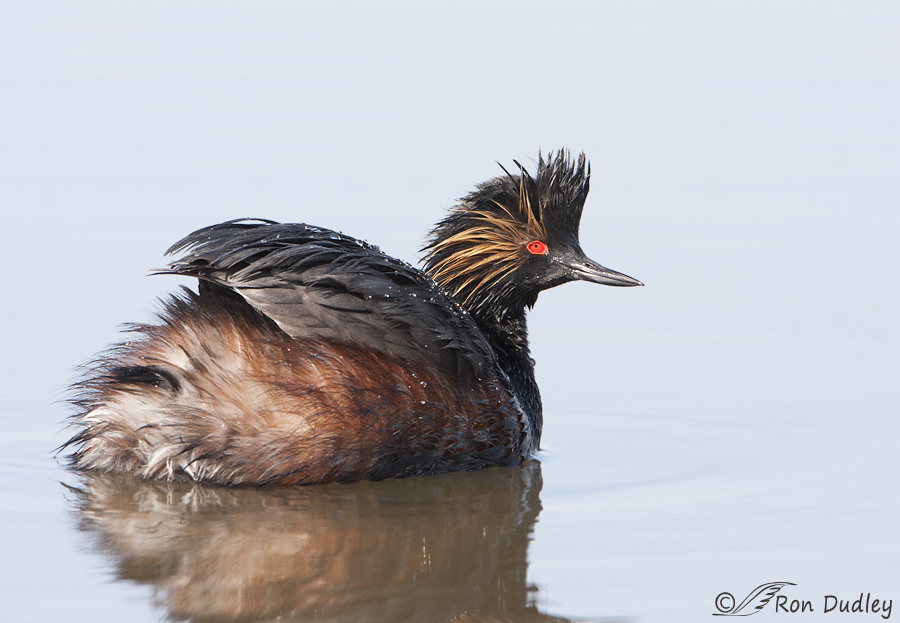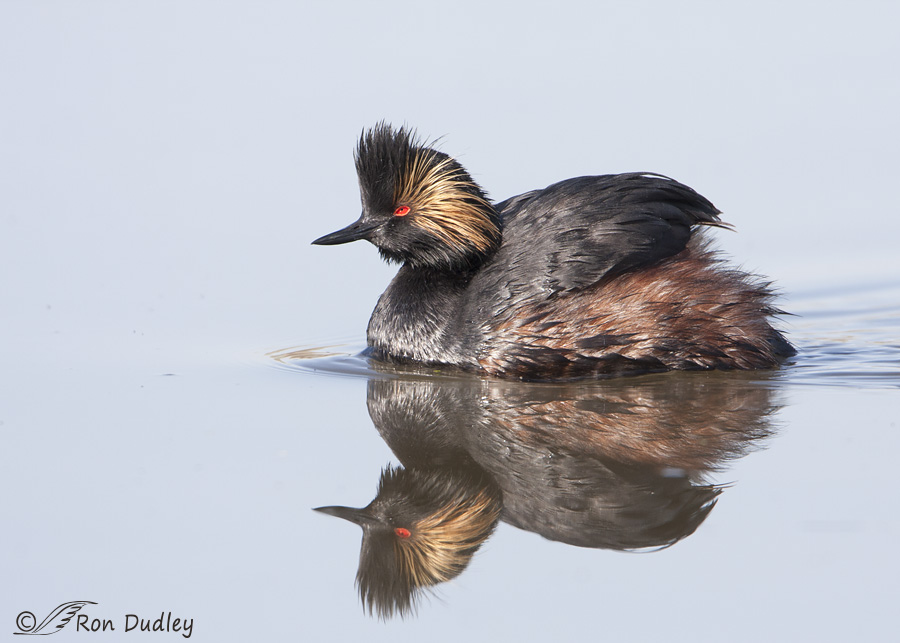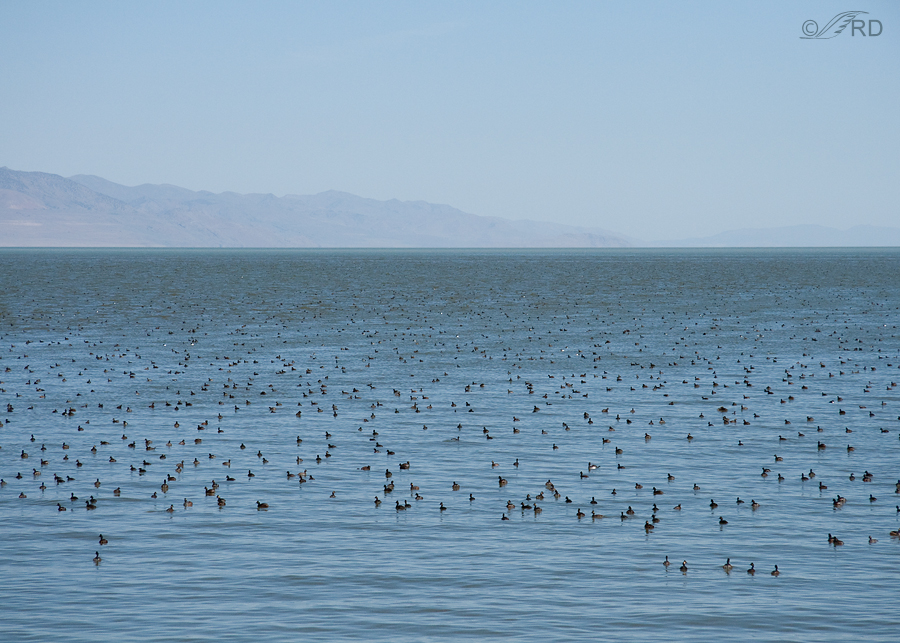Occasionally I rerun a favorite older post. This one was originally published back in December of 2016. I chose to repost it because the biologist in me gravitates toward the highly unusual biology of this little grebe and I believe that many of my readers who have never seen this post will find it interesting. For this version I’ve edited the text and tweaked the formatting.
The little Eared Grebe is one of the most biologically interesting bird species I’m aware of.

1/500, f/8, ISO 500, Canon 40D, Canon EF 500mm f/4L IS USM + EF 1.4 II Extender, not baited, set up or called in
As common as they are in northern Utah during certain times of the year, I typically can’t get close to Eared Grebes. An exception occurred a few years ago when I found several of them feeding on an insect hatch on Glover Pond near Farmington Bay. They were scurrying around on the pond as they snatched insects off the surface and occasionally one would pause and look at me with an intensely scarlet eye.

1/800, f/7.1, ISO 500, Canon 40D, Canon EF 500mm f/4L IS USM + EF 1.4 II Extender, not baited, set up or called in
I actually preferred them a little further away so I could get their entire reflection in frame on the mirror-like surface of the water.

The Great Salt Lake is one of only two primary staging areas of Eared Grebes in North America (the other is Mono Lake, CA). This photo, taken in early May along the causeway to Antelope Island, shows mind-boggling numbers of grebes from the shoreline to roughly a half mile out on the lake. And there were just as many grebes for much of the 7 mile length of the causeway. At times it’s estimated that there are 2.5 million Eared Grebes on the lake, which is over half of the entire North American population of Eared Grebes.
The physiological changes in body composition of Eared Grebes during their migration cycle are truly bizarre. Consider the following:
- When they arrive on the lake (a staging area before they continue migrating) in the fall they more than double their body weight from an average of 260 grams to more than 600 grams. They do this by adding huge fat stores and greatly increasing the mass of their digestive organs. At the same time their flight muscle mass shrinks by about 50% – to the point that they’re unable to fly. This muscle atrophy begins even before they molt their flight feathers.
- Then, before their migration south continues, they reverse the trend by fasting for 2-3 weeks which reduces their body mass to about 450 grams and they completely reorganize their body composition – digestive organ mass drops by two-thirds and leg muscles shrink, but pectoral (flight) muscle mass can more than double. When they’re able to fly again they migrate to their wintering areas.
- But it won’t be long before they have to prepare for their trip back north in the early spring, so the cycle of atrophy/hypertrophy is repeated. This happens 3-6 times per year, whenever grebes stop at one site for protracted periods of time. The pre-migratory increase of pectoral muscle and heart mass is required for migration while the pre-migratory decrease of digestive organs and leg muscle is considered a mechanism to reduce wing-loading and thus increase flight range in this poorly flying species.
- The overall result is that Eared Grebes have the longest flightless period of any volant (flighted) bird in the world, perhaps totaling 9–10 months over the course of a year. At fall staging areas alone, flightless periods average 3–4 months for adults and may reach 8 months or more in nonbreeders.
The changes in size and proportion of Eared Grebe muscles and internal organs are the most extreme known in any bird species on the planet and that matches their world record for flightless down-time.
All this makes me marvel at the incredible specialization of this most common grebe species in North America. But that specialization is also potentially an Achilles heel. They’ve become so dependent on the Great Salt Lake as a staging area it makes me fearful about what might happen to them as the lake dries up. Due to drought and mismanagement of water resources, the lake now has only 29% of the surface area it had only a few years ago.
Ron
Note: Since the original publication of this post, Great Salt Lake has rebounded significantly from its more dire situation of a few years ago but it still isn’t considered to be a “healthy” lake. In the next few years it could go either way. The fate of the Eared Grebe hangs in the balance.


Wow. Just wow. I’m so glad that I went back to read the posts I’d missed. I frequent the Mono Lake area, so the eared grebe is somewhat familiar, but I knew NONE of this information about their adaptive physiology. This is the sort of thing that I find meaning ful. Being about to ID and name birds is great, but the sort of knowledge you provide is much more interesting as well. Thank you
The weight gain / loss and flight vs flightless cycles fascinate me. I tried to drill down to find the original research publication(s) and data but, so far, only got to general descriptions. By chance, do you have a reference or a researcher name for the Eared Grebe physiology?
Thanks
Dave, changes in body composition are described in detail by this author: He’s the guy that Cornell (where I got much of my info) uses as their primary source on the subject.
“Jehl, Jr., J. R. (1997). Cyclical changes in body composition in the annual cycle and migration of the Eared Grebe Podiceps nigricollis. Journal of Avian Biology 28:132-142.”
Didn’t know that any bird did this so many times a year. I knew the western grebe like species complex also does a similar atrophy/hypertrophy.
Your photos of the grebe are stunning. What a beautiful bird! And your info about the physiological changes is remarkable and scary as I can’t imagine a body of water that can replace the GSL in the grebe’s migration route. Don’t you wonder what quirk of nature and evolution thought it was a good idea for a bird to go through the extreme body changes experienced by the Eared Grebe?
Yes, I do wonder Melanie. So much to try to understand…
Fascinating! Not sure I recall the original post, but color me intrigued by the redux! There have been lots of threats to Mono Lake as well (I’ve been there a couple of times, but never during a grebe staging — that must be something!) — when will we, as a species, ever learn.
Marty, I’ve never been to Mono Lake, even though I spent lots of time in many areas of CA years ago. It’s one of my regrets, and I have a few…
What can the average citizen do to raise awareness to the importance of the Great Salt Lake as a migratory stopover. Who do we talk to to stop further commercial degradation of this important Waypoint in the annual spring and fall migration. How do we enhance protection of this body of water.
Steven, one way is for Utah citizens to vote accordingly.
This is truly fascinating information along with some beautiful photos Ron. Also a great reminder of the importance of our natural areas and resources. I had not seen the original, and knew almost nothing about Eared Grebes, so thank you very much for reposting.
“I had not seen the original”
Thanks, Bill. I figured there were lots of blog followers in the same boat as you so a rerun was warranted. I guess I was right.
Colour me fascinated, awed, delighted, and worried. Which is quite a range for one post.
Biology is a fascinating subject and natural quirks like this blow me away. But then nature blows me away. And then I am infuriated at the greed and disdain for other species our own exhibits. Repeatedly.
“Biology is a fascinating subject.”
I’ve always thought so, EC. Which is why it was my major in college.
WOW! Just WOW! Nature never ceases to puzzle and amaze me – it IS humbling for us “know it all” humans. 😉 Sad about the botulism outbreak April talked about. I often wonder about that with Freezeout Lake here with the millions of birds that come through tho I’ve never heard of it. Of course, the migrations here tend to take place when it’s MUCH cooler.
Judy, it’s my understanding that in order for botulism to have much affect on large numbers of birds, the water source where the birds are found must have deep, persistent mud. Clostridium botulinum, the bacterium that produces the toxin, is anaerobic and the deep mud supplies the oxygenless conditions required for it to thrive. Maybe Freezeout doesn’t have deep, persistent mud.
Suspect that Freezeout doesn’t have that since they add water/let it go pretty dry from time to time. Have always had the feeling it was pretty shallow.
Ditto – stunning shots and fascinating info. I hope you take Brad up on his offer to make this compelling and convincing data available to a wider audience!
Thanks, Burrdoo. Not likely.
This is one of those great “deep in the weeds” stories about the natural world that should give all us humans a humbling pause. Good old Mother Nature; full of surprises…and novel solutions to knotty problems.
Well said, Jim. Especially your last sentence.
Very interesting and an outstanding lesson for we who are not as well versed in the biology of our birds and other members of nature. I have always been thrilled to see the few we do get, but of course nothing like GSL. If the lake was ever to dry up I wonder if they would be capable of locating another lake somewhere to accommodate their needs such as GSL does?
I doubt they could adapt very well, Everett. At least not fast enough.
Late summer last year the Willard Spur and Harold Crane wetlands, wetlands who’s waters flow into the Great Salt Lake, had a massive botulism outbreak. Thousands of birds in the two wetlands died. I also found dead and dyeing ducks in some of the east ponds at BRMBR. Ducks (shovelers, teals, mallards) were mostly effected but I did see dead grebes of all kinds in the carcasses. They washed up on the north side of Antelope Island causeway for months. Botulism grows in anaerobic water, stagnated water where fresh water is not flowing in to oxygenate the ponds, add higher temperatures and botulism grows like crazy. We have problems with botulism every summer in city parks. The birds can’t win. When more water was available last year wetlands that stood dry were flooded and managers tried to retain some of the water within the dikes to create more open water and wetlands for migratory birds, but without new water flowing in, it was perfect conditions and botulism formed.
“The birds can’t win.”
That’s for sure, April. And now, on top of everything else, they’re having to deal with avian flu.
Just ‘WOW’, that first photo! And fascinating information. Thank you.
Thanks very much, Barbara.
Had not seen this before. Thanks for reposting. Triggers thoughts in my mind regarding the expansion and shrinking of digestive system components correlated with fasting and feeding. Maybe some of this goes on in some humans some of the time?
Can some animal physiologists weigh in with thoughts?
“Maybe some of this goes on in some humans some of the time?”
Makes one wonder, doesn’t it Dave. And what about hibernating animals?
The weight gain / loss and flight vs flightless cycles fascinate me. I tried to drill down to find the original research publication(s) and data but, so far, only got to general descriptions. By chance, can you suggest a reference or a researcher name for Eared Grebe physiology?
Thanks
Ron:
I find this post so interesting that I think it is something that could be published in one of the local news outlets, like the Salt Lake Tribune or KSL. It really helps give meaning to the plight of the lake and how the health of the lake impacts a specific species. And, this transformation story is really interesting. If you agree, I would be happy to help make that happen.
“If you agree, I would be happy to help make that happen.”
Brad, to quote Doris Day, “What will be, will be”. But if that were to happen (very long shot), I’d have to rework my text. And even then, I dunno. I’d have to think about it.
Wow. Well professor, this lesson is an astonishing one. Never knew any of this. Makes me wonder how such a specific and complex (and seemingly impossible) adaptation could have ever evolved. But then again, the existence of this planet and all the life on it is a mystery to me.
There is something strangely omniscient about the whole look of this bird.
“and seemingly impossible”
That’s the way I see it, Michael. How do they DO THAT, and survive?
Wow! That is fascinating! And your pictures are stunning, as always. Being an “easterner”, I have never yet encountered this gorgeous bird. Bird biology really is fascinating, isn’t it?
“Bird biology really is fascinating, isn’t it?”
It sure is, Sheila. My fascination with bird biology had its roots when I was raising pigeons as a pre-teenager and learned about pigeon “milk”.
Wow! Great information about this bird!
Thanks, Kellie.
I’m glad that you re-published this post; I hadn’t seen it, or any
photos of this species before. That repeated pattern of weight
gain, then loss, is amazing to me, although it makes perfect sense.
Is its like known in other bird species ? It’s a stunning-looking
bird, too! Those ruby-red eyes are unforgettable, and the shading and gloss of its feathers are a beautiful framing. Thanks !
“Is its like known in other bird species?”
Kris, similar weight gain and loss is known in some other bird species but not so extreme as this.
Absolutely fascinating post today Ron. Did not know anything about Eared Grebes before this morning. Love their coloring and long head feathers.
Glad you enjoyed it, Kathleen. Thanks.
Thanks for the fascinating information. It puts a focus on key staging areas which is important for other species as well,
You’re very welcome, Bruce.